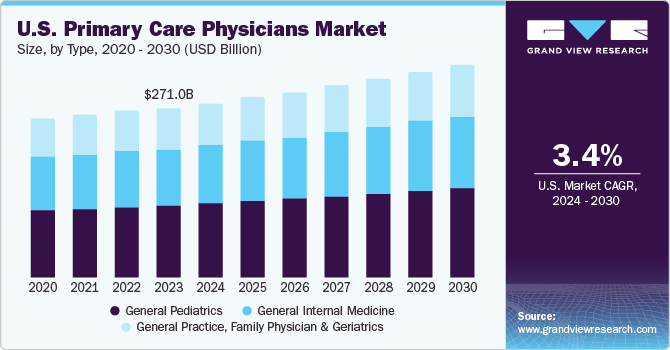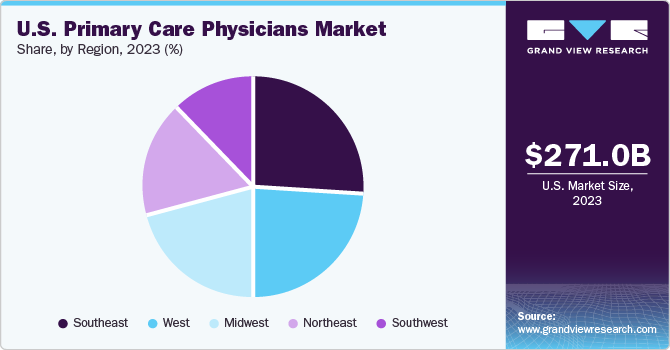- Home
- »
- Medical Devices
- »
-
U.S. Primary Care Physicians Market Size Report, 2030GVR Report cover
![U.S. Primary Care Physicians Market Size, Share & Trends Report]()
U.S. Primary Care Physicians Market Size, Share & Trends Analysis Report By Type (General Practice, Family Physician & Geriatrics, General Internal Medicine), By Region, And Segment Forecasts, 2024 - 2030
- Report ID: GVR-4-68038-675-2
- Number of Report Pages: 100
- Format: PDF, Horizon Databook
- Historical Range: 2018 - 2022
- Forecast Period: 2024 - 2030
- Industry: Healthcare
Market Size & Trends
The U.S. primary care physicians market size was estimated at USD 271.0 billion in 2023 and is projected to grow at a compound annual growth rate (CAGR) of 3.36% from 2024 to 2030. Growth can be attributed to the growing access to primary care providers, which is expected to reduce healthcare expenditure and a rise in hospitalization rate.

Primary care physicians (PCPs) practicing family medicine, internal medicine, and pediatrics provide early detection of diseases with immediate treatment, management of chronic conditions, and preventive care.
Market Dynamics
New primary care models, such as direct primary care and concierge services, are expected to increase physician practice revenue. These practice models provide annual membership to patients for primary care and preventive care, which in turn may reduce overall healthcare costs. Moreover, these practices have also collaborated with Medicare and private insurance providers to make primary care accessible and affordable.
In the U.S., employed physicians have reported that salary-based compensation most commonly follows volume-based and mixed models. As per the study of 31 physician organizations in the U.S. published in JAMA Network in January 2022, for PCPs, the volume-based compensation model was the common base compensation incentive component, with around 26 physician organizations accounting for around 68.2% of total compensation.
Programs developed by policymakers to deliver quality care by enhancing payment methods for financial incentives are expected to help physicians focus on value-based care rather than volume-based care. Moreover, patient outcomes as a measure of the quality of care are being incorporated into value-based payment models, such as incentive-based payment models, risk-bearing arrangements, and comprehensive primary care programs.
In the U.S., PCPs mostly practice in independent or small healthcare settings; however, in recent years, many physicians are now working with large physician groups or hospitals. As per the Primary Care in the United States 2019 by Robert Graham Center (RGC), around 48% of PCPs are partial or full owners of the practice, and around 48% of these providers work for employed physicians. Out of all primary care providers working in non-physician-owned practices, around 50% are in insurers, HMOs, health plans, or corporate-owned practices, and around 47% are in community health, academic, or medical centers.
COVID-19 Impact: 2.05% Increase From 2020 to 2021
Pandemic Impact
Post-COVID Outlook
COVID-19 pandemic revealed a huge gap in the U.S. healthcare infrastructure due to a shortage of physicians, a lack of PPE kits for private practices, and limited nursing & supporting staff.
After re-opening post lockdowns and reduction of movement restrictions, patients preferred virtual consultations to avoid the disease. As telehealth became a more preferred mode of consultation for patients, primary care practices witnessed reduced patient influx during second half of 2020.
Most of the private physician practices reported a significant loss of revenue, physician burnout, shutting down of practices, and furloughed staff. In a survey conducted by the Medical Group Management Association, in May 2020, around 95% of small private practices reported a negative impact of COVID-19 on their financials.
Several initiatives, such as financial relief funds and improving accessibility & availability of primary care physicians, are expected to relieve the U.S. healthcare system from financial and other burdens created by the pandemic.
COVID-19 pandemic negatively impacted the market. Physicians offering pediatric services reported shutdowns owing to a limited number of patients. Most physicians relied on telehealth and virtual care services to run their practices. Moreover, even after re-opening post lockdowns and reduction of movement restrictions, patients preferred virtual consultations to avoid disease. As telehealth became a more preferred mode of consultation for patients, primary care practices witnessed reduced patient influx by the second half of 2020.
Type Insights
In 2023, general practice, family physician, and geriatrics physicians segment dominated the market with the largest revenue share due to rising dependence on general practitioners and family physicians from Medicare beneficiaries. Family physicians are the leading specialty care providers in primary care. As per the 2022 Physician Specialty Data Report by the Association of American Medical Colleges, family medicine/general practice accounted for 118,641 active physicians in 2021 and around 60,305 active physicians.
General pediatric physician segment is anticipated to witness the fastest CAGR during the forecast period. This can be attributed to the increasing prevalence of chronic diseases in children and rising awareness among parents. However, a shortage of pediatric physicians was reported by the American Academy of Pediatrics (AAP). As per 2022 Physician Specialty Data Report by the Association of American Medical Colleges, there were around 60,305 active pediatric physicians in 2021 in the U.S. The AAP also reported inadequate distribution of pediatricians in rural areas. Thus, the demand for PCPs for children is expected to increase across the country.
General internal medicine segment is anticipated to witness significant growth during the forecast period. The practitioners play an important role in controlling the expanding healthcare cost and implementing reforms in the primary healthcare system. As per the 2022 Physician Specialty Data Report by the Association of American Medical Colleges, internal medicine held the largest number of active physicians with 120,342 active physicians in 2021.
Regional Insights
Southeast region held the largest revenue share in 2023. This can be attributed to a rise in demand for PCPs in the region and increasing government expenditure for PCPs. According to the CMS National Health Expenditure data, in 2020, healthcare expenditure for physician and clinical services was USD 61.689 billion in Florida, USD 27.21 billion in Georgia, and around USD 23.22 in North Carolina, which accounted for the states having largest expenditure.

Moreover, the demand for PCPs in the Southeast region is growing continuously due to rise in shortage of these physicians due to the pandemic. According to the Kaiser Family Foundation, as of September 2022, around 1,722 PCPs were required to remove Health Professional Shortage Area (HPSA) designation in Florida, which is the highest in the U.S.
The West region is expected to witness lucrative growth over the forecast period due to presence of highest number of active PCPs in the region. According to America's Health Rankings by the United Health Foundation, as of September 2022, there were around 342 active PCPs per 100,000 population in Alaska.
Key Companies & Market Share Insights
Duly Health and Care; ChenMed LLC; 1Life Healthcare, Inc. (One Medical Group); and MDVIP dominated the market in terms of strategic initiatives. These companies have expanded their services with the launch of new facilities, by acquiring new companies and partnerships & affiliations with physicians across the country to strengthen their presence at a national level.
-
For instance, in January 2023, Cleveland Clinic and Palantir Technologies Inc. announced a multi-year partnership aimed at providing an operational "Virtual Command Center" for Cleveland Clinic.
-
In July 2022, 1Life Healthcare, Inc. (One Medical Group) entered into a definitive agreement with Amazon for a merger, under which Amazon will acquire One Medical.
-
In July 2022, MDVIP expanded its National Primary Care Network with the addition of Richard M. Del Sesto, a board-certified internist in Rhode Island.
Key U.S. Primary Care Physicians Companies:
- MDVIP
- 1Life Healthcare, Inc. (One Medical Group)
- Rhode Island Primary Care Physicians Corporation (RIPCPC)
- Duly Health and Care (Formerly DuPage Medical Group)
- Optum, Inc.
- ChenMed LLC
- Premier Medical Associates
- Colonial Healthcare
- New West Physicians
- Crossover Health Medical Group
U.S. Primary Care Physicians Market Report Scope
Report Attribute
Details
Revenue forecast in 2030
USD 339.6 billion
Growth rate
CAGR of 3.36% from 2024 to 2030
Base year for estimation
2023
Historical data
2018 - 2022
Forecast period
2024 - 2030
Report updated
November 2023
Quantitative units
Revenue in USD million/billion and CAGR from 2024 to 2030
Report coverage
Revenue forecast, company ranking, competitive landscape, growth factors, and trends
Segments covered
Type, region
Country scope
U.S.
Key companies profiled
MDVIP; 1Life Healthcare, Inc. (One Medical Group); Rhode Island Primary Care Physicians Corporation (RIPCPC); Duly Health and Care (Formerly DuPage Medical Group); Optum, Inc.; ChenMed LLC; Premier Medical Associates; Colonial Healthcare; New West Physicians; Crossover Health Medical Group
Customization scope
Free report customization (equivalent up to 8 analyst’s working days) with purchase. Addition or alteration to country, regional & segment scope.
Pricing and purchase options
Avail customized purchase options to meet your exact research needs. Explore purchase options
U.S. Primary Care Physicians Market Report Segmentation
This report forecasts revenue growth and provides an analysis of the latest industry trends in each of the sub-segments from 2018 to 2030. For this study, Grand View Research has segmented the U.S. primary care physicians market report based on type and region:
-
Type Outlook (Revenue, USD Billion, 2018 - 2030)
-
General Practice, Family Physician and Geriatrics
-
General Internal Medicine
-
General Pediatrics
-
-
Regional Outlook (Revenue, USD Billion, 2018 - 2030)
-
Southeast
-
West
-
Midwest
-
Northeast
-
Southwest
-
Frequently Asked Questions About This Report
b. The U.S. primary care physicians market size was estimated at USD 271.0 billion in 2023 and is expected to reach USD 278.5 billion in 2024.
b. The U.S. primary care physicians market is expected to grow at a compound annual growth rate of 3.36% from 2024 to 2030 to reach USD 339.6 billion by 2030.
b. General Practice, Family Physician, and Geriatrics dominated the U.S. primary care physicians market with a share of 42.7% in 2023. This is attributed to the increasing demand for primary care services from Medicare beneficiaries.
b. Some key players operating in the U.S. primary care physicians market include MDVIP; One Medical Group, Inc., Rhode Island Primary Care Physicians Corporation (RIPCPC); ChenMed LLC; DuPage Medical Group (DMG); HealthCare Partners Medical Group; New West Physician; Crossover Health Medical Group.
b. Key factors that are driving the U.S. primary care physicians market growth include increasing demand for primary care from the insured population and rising government initiatives to improve revenue for primary care physicians.
Share this report with your colleague or friend.
![gvr icn]()
NEED A CUSTOM REPORT?
We can customize every report - free of charge - including purchasing stand-alone sections or country-level reports, as well as offer affordable discounts for start-ups & universities. Contact us now
![Certified Icon]()
We are GDPR and CCPA compliant! Your transaction & personal information is safe and secure. For more details, please read our privacy policy.
We are committed towards customer satisfaction, and quality service.
"The quality of research they have done for us has been excellent."





